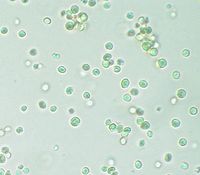
Photo from wikipedia
Nannochloropsis gaditana is a photosynthetic unicellular microalgae considered one of the most interesting marine algae to produce biofuels and food additive due to its rapid growth rate and high lipid… Click to show full abstract
Nannochloropsis gaditana is a photosynthetic unicellular microalgae considered one of the most interesting marine algae to produce biofuels and food additive due to its rapid growth rate and high lipid accumulation. Although microalgae are attractive platforms for solar energy bioconversion, the overall efficiency of photosynthesis is reduced due to the steep light gradient in photobioreactors. Moreover, accumulation of lipids in microalgae for biofuels production is usually induced in a two-phase cultivation process by nutrient starvation, with additional time and costs associated. In this work, a biotechnological approach was directed for the isolation of strains with improved light penetration in photobioreactor combined with increased lipids productivity. Mutants of Nannochloropsis gaditana were obtained by chemical mutagenesis and screened for having both a reduced chlorophyll content per cell and increased affinity for Nile red, a fluorescent dye which binds to cellular lipid fraction. Accordingly, one mutant, called e8, was selected and characterized for having a 30% reduction of chlorophyll content per cell and an almost 80% increase of lipid productivity compared to WT in nutrient-replete conditions, with C16:0 and C18:0 fatty acids being more than doubled in the mutant. Whole-genome sequencing revealed mutations in 234 genes in e8 mutant among which there is a non-conservative mutation in the dgd1 synthase gene. This gene encodes for an enzyme involved in the biosynthesis of DGDG, one of the major lipids found in the thylakoid membrane and it is thus involved in chloroplast biogenesis. Lipid biosynthesis is strongly influenced by light availability in several microalgae species, including Nannochloropsis gaditana: reduced chlorophyll content per cell and more homogenous irradiance in photobioreactor is at the base for the increased lipid productivity observed in the e8 mutant. The results herein obtained presents a promising strategy to produce algal biomass enriched in lipid fraction to be used for biofuel and biodiesel production in a single cultivation process, without the additional complexity of the nutrient starvation phase. Genome sequencing and identification of the mutations introduced in e8 mutant suggest possible genes responsible for the observed phenotypes, identifying putative target for future complementation and biotechnological application.
Journal Title: Biotechnology for Biofuels
Year Published: 2020
Link to full text (if available)
Share on Social Media: Sign Up to like & get
recommendations!